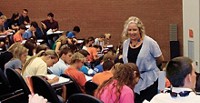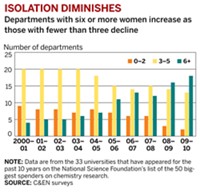Advertisement
Grab your lab coat. Let's get started
Welcome!
Welcome!
Create an account below to get 6 C&EN articles per month, receive newsletters and more - all free.
It seems this is your first time logging in online. Please enter the following information to continue.
As an ACS member you automatically get access to this site. All we need is few more details to create your reading experience.
Not you? Sign in with a different account.
Not you? Sign in with a different account.
ERROR 1
ERROR 1
ERROR 2
ERROR 2
ERROR 2
ERROR 2
ERROR 2
Password and Confirm password must match.
If you have an ACS member number, please enter it here so we can link this account to your membership. (optional)
ERROR 2
ACS values your privacy. By submitting your information, you are gaining access to C&EN and subscribing to our weekly newsletter. We use the information you provide to make your reading experience better, and we will never sell your data to third party members.
Careers
Women Now 16% Of Chemistry Faculty
C&EN's annual survey of chemistry departments reveals a little progress
by Linda R. Raber
December 22, 2008
| A version of this story appeared in
Volume 86, Issue 51
- Table 1: Top Producers Of Female Faculty
Almost 40% of female chemistry professors received Ph.D.sat these schools - Table 2: Slowth, Steady Growth
Now, 16% of chemistry professors at top 50 universities are women - Table 3: Women In Academia, 2008–09
Among the top 50 universities, women held the greatest share of chemistry professorshipsat the University of Puerto Rico, Rio Piedras; Purdue
AT THE 50 U.S. chemistry departments that spend the most on research, the fraction of women who are tenured or hold tenure-track positions rose to 16% from 15% last year (C&EN, Dec. 24, 2007, page 44). The University of Puerto Rico, Rio Piedras, and Purdue University have the largest proportions of female faculty, with 28% and 27%, respectively. In absolute numbers, Purdue has the most women on its chemistry faculty at 14, and the University of California, Los Angeles, has the second highest number, with 11. To compare, last year, the top spots were held by Rutgers University and the University of Texas M. D. Anderson Cancer Center, each with 25%, and UCLA with 24%.
These are some of the results of C&EN's most recent survey of chemistry departments in the U.S. This fall, C&EN surveyed the 50 top spenders on research as identified by the National Science Foundation (C&EN, Nov. 3, page 31). NSF's rankings are for fiscal 2006, the latest year for which data are available.
Each department provided the number of male and female tenured and tenure-track faculty holding full, associate, and assistant professorships with at least 50% of their salaries paid by the chemistry department in the 2008–09 academic year. These numbers exclude emeritus professors, instructors, and lecturers, as well as any faculty whose salaries are not paid by the chemistry department.
For 2008–09, there are a total of 1,662 chemistry faculty in the top 50 universities, of whom 263 are women. Women make up 12% of full professors, 22% of associate professors, and 24% of assistant professors at these departments. When compared with 2001 data (7%, 20%, 20%, respectively), this year's numbers suggest steady but slow progress over the long term.
THIS YEAR, for the first time, C&EN determined the Ph.D. origin of all current female chemistry faculty and found that a few schools graduate a notably large proportion of women who land faculty positions. Nearly 40% of current female faculty received their Ph.D. at one of only eight universities. By itself, UC Berkeley is the source of about 11% of current female faculty in the top 50.
C&EN also collected information to test a hypothesis that has been batted about for years, most recently in a report published by the National Academies ("Beyond Bias and Barriers: Fulfilling the Potential of Women in Academic Science and Engineering," National Academies Press, 2007). The idea is that it is pivotal to have a "critical mass" of women in a department, because once an academic department has at least 20% women, the women "start to perceive their common interests and join together to press for improvements in policies relevant to their needs," the report states. However, only 14 departments in the top 50 have the gender diversity to reach this critical mass. At the low end, seven departments have 10% women or less.
The C&EN survey also included a random sampling of women at all academic ranks in departments with the highest representation of women and in those departments with four or fewer women. Approximately 40 female faculty received confidential inquiries regarding their perceptions of inequality with their male colleagues in a number of areas, including access to laboratory space, assignment to university committees, availability of mentoring, access to graduate students, and status in departmental decision-making. These were topics developed by the Committee on the Advancement of Women Chemists. C&EN also asked about subtle or overt sexism.
The 10 responses C&EN received to these sexism-related questions tended to be extreme: either quite favorable or very negative, in approximately equivalent numbers, with very little middle ground. The sample size, however, was too small to allow any statistical analysis or to identify trends in the representation of women in chemistry departments or their satisfaction with their work environments.
Read More
- Table 1: Top Producers Of Female Faculty
- Almost 40% of female chemistry professors received Ph.D.sat these schools
- Table 2: Slowth, Steady Growth
- Now, 16% of chemistry professors at top 50 universities are women
- Table 3: Women In Academia, 2008–09
- Among the top 50 universities, women held the greatest share of chemistry professorshipsat the University of Puerto Rico, Rio Piedras; Purdue




Join the conversation
Contact the reporter
Submit a Letter to the Editor for publication
Engage with us on Twitter